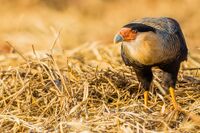Crested caracara
| Caracara | |
|---|---|

| |
| Crested caracara Caracara plancus | |
| Scientific classification | |
| Kingdom Information | |
| Domain | Eukaryota |
| Kingdom | Animalia |
| Subkingdom | Bilateria |
| Branch | Deuterostomia |
| Phylum Information | |
| Phylum | Chordata |
| Sub-phylum | Vertebrata |
| Infraphylum | Gnathostomata |
| Class Information | |
| Superclass | Tetrapoda |
| Class | Aves |
| Sub-class | Neornithes |
| Infra-class | Neoaves |
| Order Information | |
| Superorder | Passerimorphae |
| Order | Accipitriformes |
| Infraorder | Falconides |
| Family Information | |
| Family | Falconidae |
| Sub-family | Polyborinae |
| Genus Information | |
| Genus | Caracara |
| Species Information | |
| Species | C. plancus |
| Population statistics | |
| Population | 2,500,000-4,999,999 (April, 2023)[1] |
| Conservation status | Least concern[2] |
Crested caracara (Caracara plancus) is a species of bird of prey found primarily in Latin America. Despite being slow aerial fliers, and often on the ground as scavengers, the crested caracara have been placed in the family Falconidae alongside true falcons.
Name
The origin of the name "caracara" is uncertain; it may be a Spanish or Portuguese corruption of a Tupi word[3] based on the sound the bird makes. The alternate scientific name Polyborus is from the Greek, referring to the bird's seemingly gluttonous appetite.[4]
Description
Crested caracaras are 20-26 inches in length, with a wingspan of 47-52 inches, and they weigh 2.0–3.5 pounds. Females are slightly larger than males. The facial skin in front of the eyes is devoid of feathers, and red in color. A bold, black crest of feathers is present on the back of the head. The body feathers are dark brown, giving way to mottling on the upper chest, blending in with the whitish neck. Juvenile birds are dull brown overall, with more vertical streaking than banded.
When on the ground they move about on long legs, and despite being smaller than vultures, their aggressive nature allows them to take over a carcass. In addition to carrion, the birds also take live prey when the opportunity presents itself, feeding on rodents, reptiles, insects, and other small animals.
Subspecies
- Caracara plancus plancus
- Caracara plancus cheriway. Familiar in Mexico, this bird is also called the Mexican eagle, and so named in part for an Aztec legend related to the founding of their capitol city of Tenochtitlan; i.e. the Aztecs would find the site of their city if the saw an eagle perched on a cactus, clutching a snake.[5] Despite competing claims that this bird was actually a golden eagle (Aquila chrysaetos), the crested caracara has been named the national bird of Mexico.[6]
Range
Crested caracaras are found throughout the Americas, ranging as far north as Florida and the southwestern United States, south to Tierra del Fuego and the Falkland Islands in South America, living in flat, open areas to an elevation of over 8,000 feet. It prefers open landscapes, such as savannahs, cattle ranches, and montane elevations. It can tolerate man-made alterations to the environment, taking advantage of plowed fields, trash dumps, parks, and cityscapes. The two subspecies are not found within the Amazon river basin, and are separated by it.
Reproduction
Crested caracaras build large nests of sticks in trees, large cacti, but usually on the ground. Up to three eggs are laid, incubating for 28–32 days before hatching. The fledgling period takes around three months before the young fly.
References
- ↑ https://www.iucnredlist.org/species/22729784/232384538#population
- ↑ https://www.iucnredlist.org/species/22729784/232384538
- ↑ https://www.merriam-webster.com/dictionary/caracara
- ↑ http://www.peregrinefund.org/subsites/explore-raptors-2001/falcons/crstcara.html
- ↑ https://embamex.sre.gob.mx/reinounido/images/stories/PDF/Meet_Mexico/2_meetmexico-symbolsofmexico.pdf
- ↑ https://www.birdful.org/why-is-the-crested-caracara-the-national-bird-of-mexico/